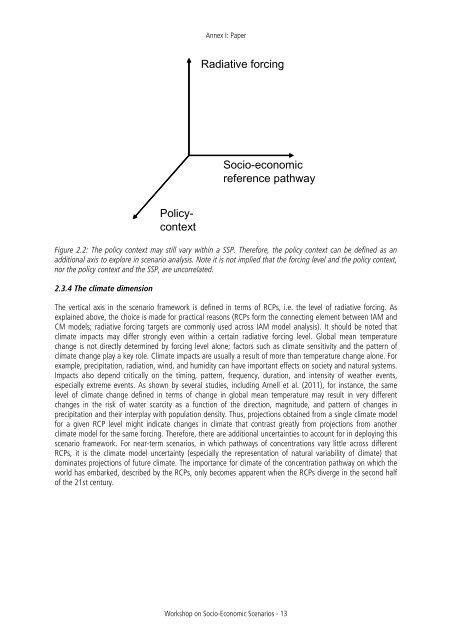Workshop Report - IPCC
Workshop Report - IPCC
Workshop Report - IPCC
Create successful ePaper yourself
Turn your PDF publications into a flip-book with our unique Google optimized e-Paper software.
Annex I: Paper<br />
Radiative forcing<br />
Socio-economic<br />
reference pathway<br />
Policycontext<br />
Figure 2.2: The policy context may still vary within a SSP. Therefore, the policy context can be defined as an<br />
additional axis to explore in scenario analysis. Note it is not implied that the forcing level and the policy context,<br />
nor the policy context and the SSP, are uncorrelated.<br />
2.3.4 The climate dimension<br />
The vertical axis in the scenario framework is defined in terms of RCPs, i.e. the level of radiative forcing. As<br />
explained above, the choice is made for practical reasons (RCPs form the connecting element between IAM and<br />
CM models; radiative forcing targets are commonly used across IAM model analysis). It should be noted that<br />
climate impacts may differ strongly even within a certain radiative forcing level. Global mean temperature<br />
change is not directly determined by forcing level alone; factors such as climate sensitivity and the pattern of<br />
climate change play a key role. Climate impacts are usually a result of more than temperature change alone. For<br />
example, precipitation, radiation, wind, and humidity can have important effects on society and natural systems.<br />
Impacts also depend critically on the timing, pattern, frequency, duration, and intensity of weather events,<br />
especially extreme events. As shown by several studies, including Arnell et al. (2011), for instance, the same<br />
level of climate change defined in terms of change in global mean temperature may result in very different<br />
changes in the risk of water scarcity as a function of the direction, magnitude, and pattern of changes in<br />
precipitation and their interplay with population density. Thus, projections obtained from a single climate model<br />
for a given RCP level might indicate changes in climate that contrast greatly from projections from another<br />
climate model for the same forcing. Therefore, there are additional uncertainties to account for in deploying this<br />
scenario framework. For near-term scenarios, in which pathways of concentrations vary little across different<br />
RCPs, it is the climate model uncertainty (especially the representation of natural variability of climate) that<br />
dominates projections of future climate. The importance for climate of the concentration pathway on which the<br />
world has embarked, described by the RCPs, only becomes apparent when the RCPs diverge in the second half<br />
of the 21st century.<br />
<strong>Workshop</strong> on Socio-Economic Scenarios - 13

















